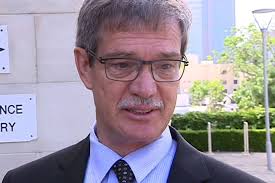WA energy minister Mike Nahan has finally seen the light about the potential of solar energy – but it will take more than a new political posture to usher in the full potential of the solar revolution in the west: there are still significant cultural and regulatory obstacles in the way.
Nahan last week conceded what had been obvious to many who understand energy markets for some time: the WA grid, based around fossil fuels and centralized generation and an expansive grid – and a massive subsidy from the government that amounts to $600 million a year – is unsustainable under its current structure.
The answer lies in a system based around decentralized energy, with rooftop solar at the core. Within a decade, Nahan, suggested, rooftop solar will be on most household and business rooftops and will account for the bulk of daytime power demands. This, admits Nahan, will push coal generation out the door.
But it is one thing to envisage a solution, it is quite another to put it into place. As Nahan touts the assets of solar – “cheap and democratic” he says – the state-owned utilities seem intent on slowing down progress.
 The energy revolution is more than just solar – it will be accompanied by energy storage, electric vehicles and some smart software that will respond to the demand and supply needs of the customer and the grid.
The energy revolution is more than just solar – it will be accompanied by energy storage, electric vehicles and some smart software that will respond to the demand and supply needs of the customer and the grid.
But Synergy, the state owned retailer, and Western Power, the state owned network company – are being accused of erecting walls where none should exist. They are asking solar customers to sign contracts promising not to install battery storage or electric vehicles, for fear of having their solar disconnected from the grid.
Take the example of Margaret River farmer Jamie Mcall, who installed a 5kw rooftop solar system five years ago.
At the time of installation, Mcall was hoping to get the prevailing feed in tariff for rooftop solar, which should have been 46c/kWh for exports back into the grid.
It didn’t happen, because of paperwork problems, but because of the metering design, when he exported solar power back to the grid, the meter turned backwards, reducing his bill. He ended up with a net tariff of the type that prevails in the much of the US, and the Nothern Territory.
That was fine – until he was contacted recently by Synergy this year announcing the installation of a new bi-directional meter.
 Mcall inquired about the feed in tariff, know in W.A. as the renewable energy buyback scheme (REBS) but was told he was not eligible for the 7.2c/kWh tariff, because his home was now defined as a business. From now on, Mcall would get nothing for the excess solar electricity he exports back into the grid.
Mcall inquired about the feed in tariff, know in W.A. as the renewable energy buyback scheme (REBS) but was told he was not eligible for the 7.2c/kWh tariff, because his home was now defined as a business. From now on, Mcall would get nothing for the excess solar electricity he exports back into the grid.
But it got worse. Synergy also informed him that if he installed battery storage, or an electric vehicle, his solar system would be “cut off”. Various emails and telephone conversations suggested that it wouldn’t just be his solar panels cut off either.
It turns out that this is a standard contract by Synergy (see below). One it insists is forced upon it by Western Power, which runs the main grid in W.A.
Synergy says the ruling is written into the current network access agreement, although there is speculation that it could be modified in the next version.
“Synergy has a responsibility to inform customers about potential issues that, if permitted, could place it in breach of its contractual agreements with the network operator,” a spokesman told One Step Off The Grid in a statement.
“The current conditions do not mean customers can not have battery storage or electric vehicle facilities. The conditions mean they can not export energy into the grid if they do. Synergy supports the development of battery storage and is currently actively involved in developing Australia’s first community storage facility in Alkimos Beach.”
Nevertheless, Mcall is not happy. “Up until this time I wasn’t thinking of battery storage or an EV. Now they telling us they not paying anything for solar, so of course I am thinking about it.
“It suddenly makes sense to put battery storage in – but now I am told I am now allowed. If solar is future, why are they screwing people who invest in it.”
Mcall has put in complaints to both the WA energy ombudsman and the ACCC.
The reason why Mcall’s situation is so powerful is that it contradicts the political rhetoric, yet is typical of consumer experience in both WA, and across the eastern states – be it in terms of low feed in tariffs, inability to export back into the grid, and soaring fixed charges.
Meanwhile, the WA government perpetuates a “capacity” payment system that Nahan admits results in the construction of peaking gas and diesel plants that are not needed and never switched on. This is thought to cost the WA electricity consumer $200 million a year.
The WA Greens have also taken up the issue, noting that Synergy’s letter threatened “disconnection” if the contract was not signed.
WA Greens Energy spokesperson Robin Chapple MLC says he will seek information this week on how many Synergy customers have been forced to sign the contract promising not to install battery storage or purchasing an electric vehicle. It will also seek to make in an election issue at the Canning bi-election, where 50 per cent of voters have rooftop solar.
“Battery storage systems are going to completely revolutionise the way that we use energy, offering West Australians the opportunity to simultaneously save money and cut their household emissions,” Chapple said.
“The Greens solar postcodes report, produced by Senator Scott Ludlam, has shown that 1 in 5 WA households now have rooftop solar – an increase of 19% in just one year – suggesting that WA is prime for the uptake of emerging battery technology.
“Battery storage systems will be at the forefront of a huge energy shift and as such are re-evaluating their Energy 2029 plan so that we have the best policy to allow West Australian’s to benefit from new energy generation technologies.
“But bizarrely the Barnett government seems to be blocking it out of the market completely; a response that is protectionist and frankly not in the best interests of their constituents.”
This story was first published on our sister site One Step Off the Grid. To sign up for the weekly newsletter, click here.










